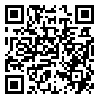Volume 15, Issue 9 (11-2015)
Modares Mechanical Engineering 2015, 15(9): 134-140 |
Back to browse issues page
Download citation:
BibTeX | RIS | EndNote | Medlars | ProCite | Reference Manager | RefWorks
Send citation to:



BibTeX | RIS | EndNote | Medlars | ProCite | Reference Manager | RefWorks
Send citation to:
Esmaeili A R, Keshavarz M, Mojra A. Optimization of hyperelastic model parameters of soft tissue based on genetic algorithm utilizing experimental mechanical dataset. Modares Mechanical Engineering 2015; 15 (9) :134-140
URL: http://mme.modares.ac.ir/article-15-3669-en.html
URL: http://mme.modares.ac.ir/article-15-3669-en.html
Abstract: (5391 Views)
Soft tissue’s cancers are related to major variations in the mechanical properties of the tissue. In recent years, a number of developing techniques have been introduced for early detection of soft tissue’s cancers. The major advantage of these methods over the common available techniques is while being noninvasive to the body, the accuracy of detection is noticeably increased. This article intends to analyze mechanical behavior of the breast tissue by considering a Mooney-Rivlin hyperelastic model. Coefficients of the model are defined by using a series of experimental mechanical datasets. For this purpose, a mechanical device is designed and fabricated base on a new noninvasive method named Artificial Tactile Sensing (ATS). The device is examined on 8 patients in 20 to 50 age range refer to “Jahad Daneshgahi Breast Diseases Clinic” while considering Helsinki agreement’s protocols. Due to wide anatomical variations of the breast tissue in individuals, 40 specified regions are examined on the tissues of all attended cases. Experimental stress versus strain datasets are collected for 40 test points. To achieve a reliable and optimized model, a genetic algorithm (GA) is used for calculating Mooney-Rivlin’s coefficients. Results confirmed that an accurate model can be afforded to estimate the soft tissue’s mechanical behavior with the least error. The model is suitable for disease diagnosis and follow-up procedure.
Article Type: Research Article |
Subject:
Biomechanics
Received: 2015/05/4 | Accepted: 2015/07/6 | Published: 2015/08/15
Received: 2015/05/4 | Accepted: 2015/07/6 | Published: 2015/08/15
| Rights and permissions | |
 |
This work is licensed under a Creative Commons Attribution-NonCommercial 4.0 International License. |







